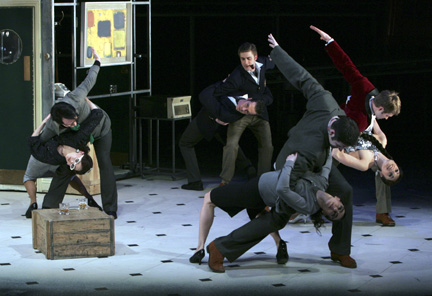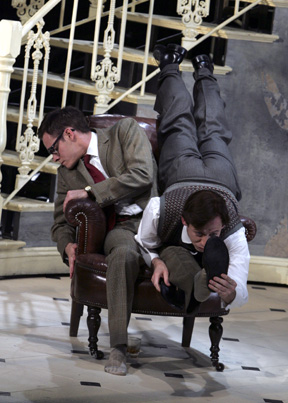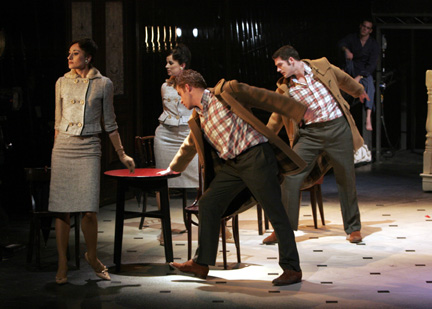Crafty Manipulations
"Play
Without Words"
Devised and directed by Matthew Bourne
BAM Harvey Theater
Brooklyn, NY
March 23, 2005
by
Susan Reiter
copyright
©2005 bySusan Reiter
 Matthew
Bourne is a master of body language, theatrical timing and suggestive
layering, to judge from the oh-so-cleverly designed and constructed 2002
work which the Brooklyn Academy of Music is currently presenting through
April 3rd. Six and a half years after Bourne's refreshingly gutsy and
witty version of "Swan Lake" was quite a succès d'estime
during its four-month run on Broadway, New Yorkers are finally getting
another chance to experience what this highly individual British artist
has been up to. In recent years, other works of his ("Car Man,"
"Nutcracker") have been seen in this country while bypassing
New York.
Matthew
Bourne is a master of body language, theatrical timing and suggestive
layering, to judge from the oh-so-cleverly designed and constructed 2002
work which the Brooklyn Academy of Music is currently presenting through
April 3rd. Six and a half years after Bourne's refreshingly gutsy and
witty version of "Swan Lake" was quite a succès d'estime
during its four-month run on Broadway, New Yorkers are finally getting
another chance to experience what this highly individual British artist
has been up to. In recent years, other works of his ("Car Man,"
"Nutcracker") have been seen in this country while bypassing
New York.
It's amazing how much mileage can still be gotten out of the "is it theater or is it dance, and who should be covering it?" debate that seems to arise periodically. Susan Stroman's "Contact" in 1999, and Twyla Tharp's "Movin' Out," a two-hour dance work presented (and always intended) as a commercial Broadway venture, were recent lightning rods for these questions and confounded those who need ready labels. Bourne seems to cleverly ride the publicity bonanza his boundary-crossing, label-defying work, inspired by Joseph Losey's 1963 film "The Servant," has invited. He cheekily implies that dance audiences aren't up to meaty or serious subject matter, telling Time Out New York, "most dance doesn't tackle particularly deep subjects"—as though by marketing this work so completely as a theater event, more thoughtful audiences will find their way to it.
In that same interview, he aptly describes "Play Without Words" as "choreographed naturalistic period movement." What we see on stage is clearly dance, closely timed to the insinuating rhythms and moody strains of Terry Davies' terrific jazz score. Bourne often exaggerates behavior and posture so that what begins as "naturalistic" is heightened, and taken into another realm by its deft timing and pacing.
 The
extra frisson of his multiple casting—two or three performers simultaneously
embodying each character—contributes a great deal to the subtle
emotional layering and cinematic stylization of the work. Dressed identically,
the characters-in-triplicate often appear simultaneously in different
parts of Lez Brotherston's brilliantly conceived set, like variations
on a theme. Their related, complimentary enactments of relationships and
situations often create a split-screen effect. The doubling and tripling
at times seem more a clever conceit than a dramatic necessity, given the
slyly efficient way Bourne maneuvers everyone around. But the subtle variations
and overlapping confrontations also add an ambiguity and density to the
drama's highly charged class conflicts and sexual standoffs.
The
extra frisson of his multiple casting—two or three performers simultaneously
embodying each character—contributes a great deal to the subtle
emotional layering and cinematic stylization of the work. Dressed identically,
the characters-in-triplicate often appear simultaneously in different
parts of Lez Brotherston's brilliantly conceived set, like variations
on a theme. Their related, complimentary enactments of relationships and
situations often create a split-screen effect. The doubling and tripling
at times seem more a clever conceit than a dramatic necessity, given the
slyly efficient way Bourne maneuvers everyone around. But the subtle variations
and overlapping confrontations also add an ambiguity and density to the
drama's highly charged class conflicts and sexual standoffs.
The centerpiece of Brotherston's set, representing the home of the spoiled, wealthy young Anthony, features two connecting staircases that meet in a small platform at the top; a pantry-like area with two swinging doors is below. This piece turns so that we see it from a variety of perspectives. Around and behind is an imaginatively skewed evocation of 1960s London—a large phone box and a miniature one, apartment houses with windows that light up and go dark. Longtime collaborators, Bourne and Brotherston are clearly on each other's wavelengths, and Bourne makes effortlessly brilliant use of all the set's possibilities. The intricacy of all the entrances, exits and confrontations is amazing, yet everything happens in a direct, matter-of-fact way, as though it was all inevitable.
The opening scene, where we are introduced to the major players and pick out their multiple identical figures amid a sweeping parade of people heading for their destinations, is a mesmerizing swirl of movement. It's busy, yet shaped with impeccable clarity. We can immediately spot the three impossibly sleek, impeccably coiffed Glendas—tall, slim, gliding in their high heels and evoking Audrey Hepburn. The three Anthonys are handsome in a callow way, bespectacled, neatly dressed, trying hard to act confident. The Prentices—the name Bourne gives to the pivotal servant character—move with calm deliberation, their faces a blank that clearly conceals a great deal. Two women double as Sheila, whose hair is always loose (while Glenda's never comes undone from its neat chignon) and carry themselves more loosely, with an air of being ready for anything.
 Bourne
brings in—and clearly (along with Brotherston, who also designed
the costumes) has a great deal of fun with the fashions and iconic looks
of the swinging 60s. "Play without Words" reflects that era
in a way that Losey's film does not. Tony (as the master is called in
the film) is a stuffy guy who's not particularly tied into the trends
of the moment. His fiancée Susan seems plain and almost dowdy compared
to Bourne's icy, glamorous Glenda. They smoke a great deal, with an air
of affected sophistication, and are seen dancing in a club, but mostly
they inhabit a glum, insular world.
Bourne
brings in—and clearly (along with Brotherston, who also designed
the costumes) has a great deal of fun with the fashions and iconic looks
of the swinging 60s. "Play without Words" reflects that era
in a way that Losey's film does not. Tony (as the master is called in
the film) is a stuffy guy who's not particularly tied into the trends
of the moment. His fiancée Susan seems plain and almost dowdy compared
to Bourne's icy, glamorous Glenda. They smoke a great deal, with an air
of affected sophistication, and are seen dancing in a club, but mostly
they inhabit a glum, insular world.
Bourne has definitely given a richer, fascinating milieu for this tale of manipulation, in which the dutiful manservant sets in motion a series of machinations and impersonations that rock Anthony's world. The layered action, and similar-yet-slightly-different ways in which scenes are played out, sometimes have the feel of a chess game, so
The crucial seduction of Anthony by Sheila takes off from the film's sequence, with its kitchen-table setting and dripping faucet, but creates its own deliberately choreographed power struggle in which Anthony is sure to be the loser. (One wonders if Bourne is knowingly or unwittingly alluding to the seduction scene in Birgit Cullberg's "Miss Julie," in which another lower-class type introduces chaos into an ordered, upscale household.) Introduced into his world by Prentice, Sheila has been presented as the prototypical saucy maid, knowingly inflaming Anthony's passions. Their inevitable coming together—all part of Prentice's savvy scheming—shows her completely in control, calling all the shots. Poor Anthony loses his glasses, but even with them on he hasn't been seeing what's happening all around him.
"Play Without Words" left me filled with admiration for its sense of style, itselegant way of manipulating bodies and layering effects. It was a feast for the eyes, but it did not engage the mind very deeply. Bourne is crafty, sly and endlessly inventive, but once it was over, I also felt that he's a masterful manipulator, rather than a true communicator.
All photos by Richard Termine.
Volume 3,
No. 13
March 21, 2005
copyright
©2005
Rita Felciano
www.danceviewtimes.com
|
|
|